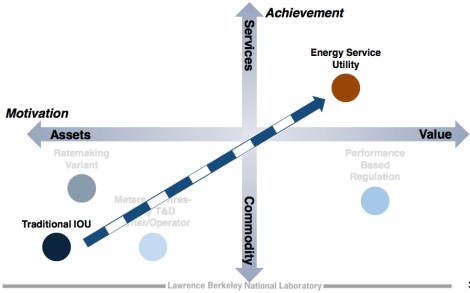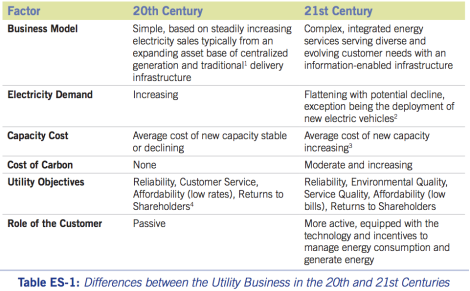I’ve now written, oh, it seems like a kabillion posts on what’s wrong with electric utilities and how they might be adapted for the 21st century. All of my thinking on this subject has been informed by smart work from other folks, but I didn’t include a lot of links or block quotes or charts’n’graphs, because I was struggling to make the posts compact and readable by normal humans.
So here, then, is some further reading on the subject. I’m sure I’m leaving a ton of stuff out, so please email me or leave a comment if there’s something else you think should be included.
Wonky reports
The report that started it all, from the Edison Electric Institute: “Disruptive Challenges: Financial Implications and Strategic Responses to a Changing Retail Electric Business” [PDF]. It captures the U.S. utility perspective on the “death spiral” it believes could be brought about by distributed energy.
—
The best thing I’ve read on utilities and distributed energy is a report from eLab, the electricity arm of the Rocky Mountain Institute, called “New Business Models for the Distribution Edge.” (Yes, that’s where I got “distribution edge.”) It’s written in plain language, fairly short, and best of all, comes to conclusions similar to mine. I’m particularly fond of what it describes as the “Independent Distribution Network Operator,” or DNO, the ultimate evolution of the smart utility, which it describes thusly:
The utility’s distribution wires function is separated from the electricity supply function; the former remains a regulated monopoly business. The wires company is subject to performance-based regulation that provides it with strong incentives to earn higher rates of return by minimizing costs. The distribution utility is encouraged to develop pricing mechanisms and market-based incentives for customers and distributed resource developers to develop these resources in ways that reduce distribution system costs.
Sounds about right. You’ll want to follow all of eLab’s work.
—
The folks at the Environmental Energy Technologies Division of Lawrence Berkeley National Laboratory, or EETDLBNL as no one calls it, have a great presentation called “Utility Business Models in a Low Load Growth/High DG Future: Gazing into the Crystal Ball?” Despite the weird misuse of the question mark in the title, it does a good job of introducing the issues. One thing it does really well is show where utility models are now and the ways they could progress, both incrementally and fundamentally. This is the dream:

LBNLClick to embiggen.
It makes sense, I promise. Read the presentation.
—
In May, the Princeton-based Distributed Energy Roundtable, a group of policymakers, regulators, utility reps, industry types, and academics, released the results of their collaboration: “Valuing Distributed Energy: Economic and Regulatory Challenges,” authored by Travis Bradford and Anne Hoskins. I mentioned in my last post that one of the most important tasks in years ahead is to properly value distributed energy and energy services. This white paper gets pretty deep into how that can work. Super-interesting.
—
Ceres put out a great paper on utility evolution a few years ago called “The 21st Century Electric Utility: Positioning for a Low-Carbon Future” [PDF]. Here’s the report’s summary of the differences between 20th and 21st century utilities:

CeresClick to embiggen
—
Big-time consultancy Deloitte had a report earlier this year called “Beyond the math: Preparing for disruption and innovation in the US electric power industry.” There’s lots more from Deloitte on related subjects here.
—
The Interstate Renewable Energy Council put out a report on “A PURPA-based approach to promoting DG growth” [PDF], which is way more interesting than it sounds. It’s about using the Public Utility Regulatory Policies Act of the late 1970s to appropriately value the benefits of distributed energy.
—
Peter Fox-Penner is a bit of a grid guru; if you’re looking for an accessible book-length introduction to these issues, you can’t beat his Smart Power (and all his other work).
—
If you want to get a comprehensive view of the U.S. grid and its challenges, you need “The Future of the Electric Grid,” an interdisciplinary study by MIT. It’s a beast, but if you can get through all of it, you’ll know everything.
—
Eurelectric, the European electricity sector trade group, recently released a big ol’ report called “Utilities: Powerhouses of Innovation” [PDF]. Rather than the somewhat gloomy assessment offered by its U.S. counterpart, Eurelectric looks forward to how utilities can aggressively innovate to take advantage of current trends. Here are the five take-home recommendations, for your nerdy pleasure:

EurelectricClick to embiggen.
The first one is, in my humble estimation, the most important and the key to the others.
Shorter articles and briefs
One of the smartest and most knowledgable people writing on this subject is Jesse Berst over at SmartGridNews. I recommend two short articles to get started: “From volume to value: Why utilities must change their business model (and one way to get started)” and “Why every utility must learn the word transactive.” Both are accessibly written and smart.
—
Chris Nelder is smart about this like he’s smart about everything energy-related. Read his two-parter: “Can the Utility Industry Survive the Energy Transition?” and “Private Utilities and the Distributed Energy Juggernaut.”
—
Rob Day wrote an interesting post a couple of months ago urging utilities to invest in distribution-edge technologies and services through unregulated subsidiaries.
—
Forbes had a great write-up of the EEI paper mentioned up top and its implications.
—
Here’s a brief from consultants at Bain & Company (remember them?) on how distributed energy will put stress on conventional utilities.
—
The Center for Climate and Energy Solutions has a nice rundown of the various emerging technologies at the distribution edge and the factors (including utilities) that are preventing their wider uptake.
—
What did I miss? I’ll add things as they come in.
—
UPDATES:
Here’s a super-wonky paper from Jesse Jenkins and Ignacio Pérez-Arriaga at MIT: “The Remuneration Challenge: New Solutions for the Regulation of Electricity Distribution Utilities Under High Penetrations of Distributed Energy Resources and Smart Grid Technologies.” It’s about the best way to compensate distribution utilities in the brave new world.
And here’s another good one: “Leading the Next Era of Electricity Innovation: The Grid Modernization Challenge and Opportunity in the Northeast.”
John Farrell at the Institute for Local Self-Reliance has a great report called “Beyond Utility 2.0 to Energy Democracy.” As the title indicates, it argues that the shift to a more decentralized grid is a good opportunity to strengthen local control over power.
Check out the e21 Initiative, a coalition of midwestern utilities and nonprofits trying to game out the utility of the future.
A good deep dive into “utility 2.0” from Public Utilities Fortnightly.




